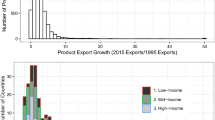Abstract
This paper uses a tailor-made new data set of 3,390,871 observations for German exports to non-EU countries at the firm-product-destination level in 2011 to investigate the link between the amount of firms’ exports and the difference in time zones between Germany and the destination countries. The results indicate that including firm and product level heterogeneity is important. When distance to destination countries is controlled for, time zones only decrease exports for smaller exporters and for intermediate goods. The quantity of exports declines with increasing time difference within a firm for a given product for exports to the West (where time difference to Germany is negative) but not the East.
Similar content being viewed by others
Notes
For a comprehensive survey of empirical studies that use transaction level data at the firm-product-destination level see Wagner (2016).
We focus on exports to non-EU countries because time zones arguably matter less inside the EU. Furthermore, policy made trade barriers do not matter inside the EU, and data on intra-EU trade are collected differently.
This identifier is missing for less than 1% of all export transactions for various reasons including that exporters do not have a German tax identification number. Observations without a firm identifier were dropped from the sample that is used in the empirical investigation.
For an empirical study based on the same data used here that estimates a standard gravity model for German exports without including information on the time-zone difference see Wagner (2017).
Note that the effect runs from time zone differences to exports of goods, and not vice versa, although there is (at least) one example for reverse causality. In 2011, Samoa and Tokelau changed time zones to align themselves more closely with their main trading partners, Australia and New Zealand (Bista and Tomasik 2015, p. 1335).
For information on the regional distribution of German exports in 2011 see Statistisches Bundesamt, Statistisches Jahrbuch 2012, p. 413ff.
Given that the control variables serve as controls only in the empirical models we do not comment on the results for the estimated regression coefficients.
This estimated effect is of the same order of magnitude as the estimated effect of distance reported in Wagner (2017) from an empirical model that does not control for time-zone difference.
For the conversion of the HS6 classification of goods used in the transaction data to the Basic Classes of Goods see United Nations (2002) Statistical Papers Series M No. 53, Rev. 4, p. 5ff. Details are available on request.
I thank the associate editor and the referees for suggesting these robustness checks.
References
Anderson, Edward. (2014). Time differences, communication and trade: Longitude matters II. Review of World Economics, 150(2), 337–369.
Bahar, D. (2018). The hardship of long distance relationships: Time zone proximity and knowledge transmission within multinational firms. CESifo Working Papers 7104, June.
Bastos, P., & Silva, J. (2010). The quality of a firm’s exports: Where you export to matters. Journal of International Economics, 82(2), 99–111.
Bista, R., & Tomasik, R. (2015). The not so distant effect of distance within a time zone. Applied Economics Letters, 22(16), 1335–1339.
Bista, R., & Tomasik, R. (2017). Time zone effects and the margins of exports. The World Economy, 40(6), 1053–1067.
Christen, E. (2017). Time zones matter: The impact of distance and time zones on services trade. The World Economy, 40(3), 612–631.
Dettmer, B. (2014). International service transactions: Is time a trade barrier in a connected world? International Economic Journal, 28(2), 225–254.
Disdier, A.-C., & Head, K. (2008). The puzzling persistence of the distance effect on bilateral trade. Review of Economics and Statistics, 90(1), 37–48.
Egger, P. H., & Larch, M. (2013). Time zone differences as trade barriers. Economics Letters, 119(2), 172–175.
Hallak, J. C. (2006). Product quality and direction of trade. Journal of International Economics, 68(1), 238–265.
Hattari, R., & Rajan, R. S. (2012). Sources of foreign direct investment flows to developing Asia: The importance of time zone. China Economic Policy Review, 1(2), 1250013.
Head, K., & Mayer, T. (2014). Gravity equations: Workhorse, Toolkit, and Cookbook. Handbook of International Economics, 4, 131–195.
Krugman, P. R., Obstfeld, M., & Melitz, M. J. (2015). International economics (10th ed.). Boston, MA: Pearson.
Mayer, T., & Zignago, S. (2011). Notes on CEPII’s distance measures: The GeoDist database. CEPII Document de Travail No. 2011-25, December.
Rauch, J. E. (1999). Networks versus markets in international trade. Journal of International Economics, 48(1), 7–35.
Stein, E., & Daude, C. (2007). Longitude matters: Time zones and the location of foreign direct investment. Journal of International Economics, 71(1), 96–112.
Wagner, J. (2016). A survey of empirical studies using transaction level data on exports and imports. Review of World Economics, 152(1), 215–225.
Wagner, J. (2017). Distance-sensitivity of German exports: first evidence from firm-product level data. Applied Economics Letters, 24(3), 140–142.
Author information
Authors and Affiliations
Corresponding author
Additional information
All computations were done at the Research Data Centre of the Federal Statistical Office in Wiesbaden. I thank Melanie Scheller for preparing the transaction level data for exports and for checking the output of my do-files for the violation of privacy. The micro data used are strictly confidential but not exclusive; see http://www.forschungsdatenzentrum.de/datenzugang.asp for information on how to access the data. To facilitate replications the Stata do-file used is available from the author on request. I thank Lindsay Oldenski (the associate editor) and two anonymous referees for very helpful comments on earlier versions of this paper.
About this article
Cite this article
Wagner, J. Time zones and German exports: first evidence from firm-product level data. Rev World Econ 155, 181–198 (2019). https://doi.org/10.1007/s10290-018-0330-8
Published:
Issue Date:
DOI: https://doi.org/10.1007/s10290-018-0330-8




